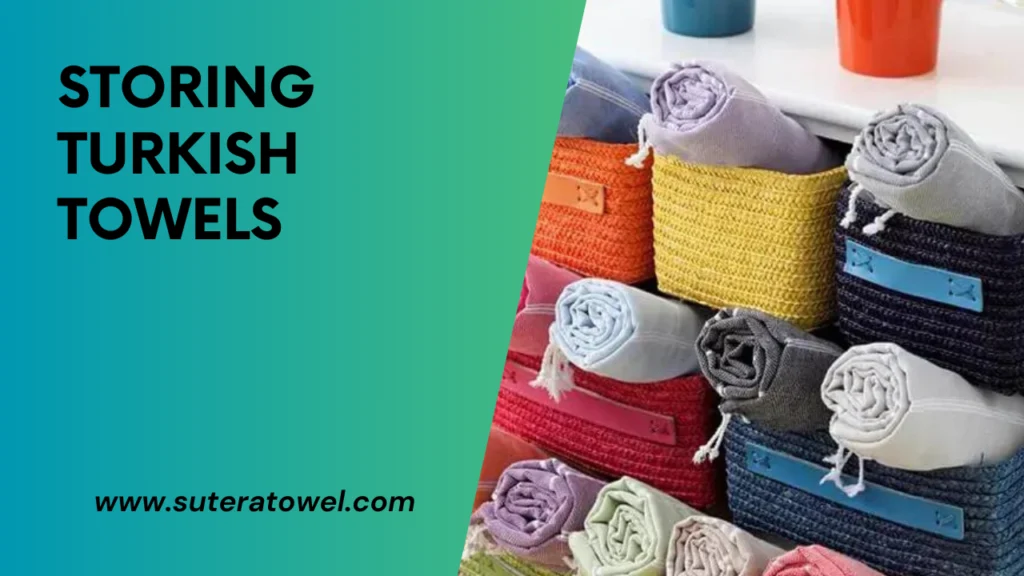To wash a Turkish towel, machine wash it in cold water and tumble dry on low heat. Turkish towels are a popular choice for towels due to their absorbency and softness.
However, like any other towels, they need to be regularly washed to maintain cleanliness and freshness. The good news is, that washing a Turkish towel is a simple process. Just toss it in the washing machine with cold water and a mild detergent.
Avoid using bleach or fabric softener as it may damage the fibers. Once washed, tumble dry the towel on low heat or hang it to air dry. Following these steps will ensure that your Turkish towel stays clean and in good condition for long-lasting use.
- 1 Understanding The Different Types Of Turkish Towels
- 2 Preparing Your Turkish Towels For Washing
- 3 Washing Turkish Towels Properly
- 4 Drying Turkish Towels
- 5 Storing Turkish Towels
- 6 Removing Stains From Turkish Towels
- 7 Dealing With Fading Colors
- 8 Fixing Snags And Wrinkles
- 9 Regular Maintenance To Extend Lifespan
- 10 Alternative Uses For Turkish Towels
- 11 Frequently Asked Questions On How To Wash A Turkish Towel
- 12 Conclusion
Understanding The Different Types Of Turkish Towels

Discover all the different types of Turkish towels and learn how to properly wash them for long-lasting use. From peshtemal to hammam towels, this guide covers it all. Keep your Turkish towels fresh and soft with these easy washing tips.
Turkish towels are known for their quality and versatility. Whether you are using them at the beach, in the gym, or in your everyday life, knowing how to properly care for your Turkish towels is essential to maintaining their durability and functionality.
In this blog post, we will guide you through the step-by-step process of washing Turkish towels. But before we dive into the specifics, let’s take a moment to understand the different types of Turkish towels available.
Thin And Lightweight Towels For Quick Drying:
- Lightweight and easy to carry, perfect for travel and outdoor activities.
- Quick-drying fabric that allows you to use the towel multiple times throughout the day.
- Can be used as a beach towel, sarong, or even a scarf.
- Ideal for those who prefer a minimalist and portable option.
Thick And Plush Towels For Maximum Absorbency:
- Luxurious and soft, providing a spa-like experience.
- Designed to absorb water efficiently, making them perfect for bath time.
- Offers excellent coverage and warmth, often used as a bathrobe.
- Heavy and dense texture enhances durability for long-lasting use.
Now that you have a better understanding of the different types of Turkish towels, you can choose the one that suits your needs. Whether you opt for a thin and lightweight towel for quick drying or a thick and plush towel for maximum absorbency, proper care is crucial to maintain their quality.
In the next section, we will go over the essential steps for washing your Turkish towels, ensuring they stay fresh and absorbent for years to come.
Preparing Your Turkish Towels For Washing

To properly wash your Turkish towels, follow these steps: start by machine washing them in cold water on a delicate cycle, avoid using bleach or fabric softener, tumble dry on low heat let them air dry, and avoid ironing.
With these tips, your Turkish towels will stay soft and absorbent for longer.
Before tossing your Turkish towels into the washing machine, it’s essential to take a few simple steps to ensure their longevity and maintain their softness. Properly preparing your Turkish towels for washing will help you avoid any surprises and keep them looking their best.
Here are a few key tips to follow:
Checking The Care Label For Specific Instructions:
- Read the care label: Begin by checking the care label on your Turkish towels for any specific washing instructions. The manufacturer may provide guidance on water temperature, detergent type, and any other special care that your towels require.
- Water temperature: Most Turkish towels can be safely washed in warm water, using cold water for the rinse cycle. However, it’s always best to follow the recommendations on the care label.
- Detergent choice: Opt for a mild detergent that is free from bleach and harsh chemicals. Harsh detergents can strip the natural fibers of your Turkish towels and reduce their softness over time.
- Avoid fabric softeners: Turkish towels are known for their natural softness, so there’s no need to use fabric softeners. These products can leave residues on the fibers, reducing their absorbency.
Sorting Turkish Towels By Color And Fabric Type:
- Sort by color: To prevent color bleeding, separate your Turkish towels into light and dark piles before washing them. This will help preserve the vibrant colors and prevent any unsightly color transfer.
- Sort by fabric type: Turkish towels come in various fabrics, including cotton, linen, or bamboo. It’s a good practice to sort them by fabric type to ensure each type receives the appropriate care during washing. This will prevent any potential damage or discoloration.
- Check for stains: Before washing, take a close look at your Turkish towels for any stains. Spot-treating stains prior to washing can help ensure they are fully removed during the wash cycle.
- Avoid overloading the machine: Turkish towels need space to move freely during the wash cycle, so avoid overloading the washing machine. This will allow for thorough rinsing and prevent fibers from becoming tangled or damaged.
By following these simple steps to prepare your Turkish towels for washing, you can maintain their softness, and vibrant colors, and extend their lifespan. Remember to always refer to the care label for specific instructions, sort them properly by color and fabric type, and avoid overloading the washing machine.
With the right care, your Turkish towels will continue to provide you with luxurious comfort for years to come.
Washing Turkish Towels Properly

Learn how to properly wash your Turkish towels with these simple guidelines. Keep your towels in pristine condition by following these easy steps.
Turkish towels are not only functional but also add a touch of elegance to your bathroom decor. However, to ensure that they remain soft, fluffy, and absorbent over time, it’s important to wash them properly. In this section, we will discuss the key steps to washing Turkish towels to maintain their quality and prolong their lifespan.
Using The Right Water Temperature For Each Type Of Towel:
- For new Turkish towels, always refer to the manufacturer’s guidelines for the recommended water temperature.
- Generally, a warm water setting of around 40°C (104°F) is suitable for most cotton Turkish towels.
- Colorful or patterned towels may require a colder water temperature to prevent color fading or bleeding. Use a cool water setting, around 30-40°C (86-104°F), for such towels.
- Avoid using hot water as it can weaken the fibers and cause shrinkage.
Choosing The Appropriate Detergent For Optimal Results:
- Opt for a mild and gentle detergent formulated for delicate fabrics. Avoid using harsh chemicals or bleach as they can damage the towel’s fibers and affect its absorbency.
- Look for detergent options that are free from optical brighteners or enzymes, as these additives can leave residues on the towels and reduce their softness.
- Measure the detergent carefully according to the specified guidelines on the packaging. Using too much detergent can leave a soapy residue, while using too little may not effectively clean the towels.
Avoiding The Use Of Fabric Softeners:
- Turkish towels are naturally soft and do not require fabric softeners. In fact, using fabric softeners can create a waxy buildup on the fibers, reducing their absorbency and making them less effective.
- Instead, consider using natural alternatives like white vinegar or baking soda in the rinse cycle. These can help maintain the softness and freshness of the towels without leaving any residue.
By following these simple steps, you can ensure that your Turkish towels remain in top condition wash after wash. Remember to always check the manufacturer’s guidelines for specific care instructions and enjoy the plush, luxurious feel of your towels every time you use them.
Drying Turkish Towels

Learn the proper way to wash your Turkish towels to keep them soft and fluffy. Follow these easy steps to ensure they stay in top condition for years to come.
Turkish towels are not only soft and absorbent, but they’re also versatile and easy to care for. After washing your Turkish towel, it’s important to dry it properly to ensure its longevity and maintain its softness. When it comes to drying Turkish towels, you have two options: air drying and machine drying.
Let’s take a look at each method and explore some tips for preventing towel shrinkage and preserving their softness.
Deciding Between Air Drying And Machine Drying:
- Air drying:
- Hang your Turkish towel on a clothesline or drying rack in a well-ventilated area.
- Make sure the towel is fully extended to allow air to circulate evenly.
- Avoid direct sunlight exposure to prevent potential color fading.
- Flip the towel occasionally to promote even drying.
- Patience is key, as air drying may take longer compared to machine drying.
- Machine drying:
- Set your dryer to a low or delicate heat setting to avoid damaging the towel’s fibers.
- Tumble dry with a few dryer balls or clean tennis balls to help maintain the towel’s fluffiness and prevent clumping.
- Remove the towel from the dryer promptly once it’s dry to prevent over-drying and potential wrinkles.
- Avoid using dryer sheets or fabric softeners as they can leave residue on the towel and affect its absorbency.
Tips For Preventing Towel Shrinkage And Preserving Softness:
- Use cold water when washing your Turkish towel to minimize shrinkage.
- Avoid overloading the washing machine to allow sufficient water and detergent distribution.
- Opt for a mild, gentle detergent to avoid harsh chemicals that can damage the towel’s fibers.
- Skip the use of bleach as it can weaken the fibers and cause discoloration.
- Consider adding a cup of white vinegar to the rinse cycle occasionally to remove detergent residue and maintain softness.
- Avoid excessive heat exposure during drying, as high temperatures can lead to shrinkage and roughness.
- Shake your Turkish towel vigorously after washing to fluff the fibers and enhance softness.
- If needed, iron the towel on a low or medium heat setting to smooth out wrinkles, but be cautious not to apply too much heat directly.
- Store your Turkish towel in a cool, dry place when not in use to prevent moisture buildup and maintain its freshness.
By following these drying techniques and tips, you can ensure that your Turkish towels remain soft, fluffy, and ready for use. Take care of your towels, and they will continue to provide you with warmth and comfort for years to come.
Storing Turkish Towels

Discover the best way to care for your Turkish towels. Learn how to wash them properly to maintain their softness and longevity.
Turkish towels are renowned for their absorbency, softness, and durability. To ensure that your towels remain in excellent condition for years to come, proper storage is essential. Follow these guidelines for folding techniques and preventing dampness and mold growth in your storage areas.
Folding Techniques For Maximizing Storage Space:
- Accordion fold: Fold the towel in half lengthwise, then fold it in half again. Repeat this process until the towel is folded into a long strip. Finally, fold the strip in half or thirds, depending on the desired width.
- Rolling fold: Start by folding the towel in half lengthwise. Then, tightly roll the towel from one end to the other. Rolling the towel not only saves space but also prevents creases and wrinkles.
- Stacked fold: Begin by folding the towel in half lengthwise, then fold it in half again. Place the folded towel on top of a stack of similar towels. Repeat this process until the stack is complete.
Avoiding Dampness And Mold Growth In Storage Areas:
- Choose a cool and dry location: Find a storage area that is well-ventilated and away from excessive heat or humidity. Avoid storing towels in a basement or attic, as these areas are prone to dampness.
- Use breathable storage containers: Opt for fabric or mesh containers instead of plastic bags or airtight containers. These allow air circulation, preventing moisture buildup.
- Keep towels dry before storing: Make sure the towels are completely dry before placing them in storage. Any residual moisture can lead to mold and musty odors.
- Rotate towels regularly: To prevent moisture accumulation, rotate the towels on a regular basis. This ensures that all towels receive proper ventilation.
- Add moisture-absorbing products: Place moisture-absorbing products, such as silica gel packets or activated charcoal, in the storage area. These help to absorb excess moisture and prevent mold growth.
By implementing these folding techniques and following proper storage practices, you can extend the lifespan of your Turkish towels and maintain their exceptional quality. Remember to keep them in a cool, dry environment and ensure they are thoroughly dry before storing.
With these tips in mind, you can enjoy the softness and comfort of your Turkish towels for years to come.
Removing Stains From Turkish Towels
Learn how to effectively remove stains from Turkish towels with these simple tips. Keep your towels looking fresh and clean by following the proper washing techniques for Turkish towels.
Turkish towels are not only incredibly soft and absorbent, but they also add a touch of luxury to your bathroom. However, with regular use, they may start to show signs of wear and stains. No need to worry though, as we have some effective tips to help you remove those stubborn stains from your Turkish towels.
Whether it’s makeup, oil, or wine stains, we’ve got you covered.
Treating Specific Stains Like Makeup, Oil, Or Wine:
- Makeup: If you accidentally get makeup on your Turkish towel, act quickly to prevent the stain from setting. Here’s how you can remove makeup stains:
- Gently scrape off any excess makeup using a spoon or dull knife.
- Blot the stain with a clean cloth or paper towel to remove as much of the makeup as possible.
- Mix a solution of equal parts liquid dish soap and hydrogen peroxide.
- Apply the solution to the stain and gently rub it in.
- Let it sit for 10-15 minutes, then rinse the towel thoroughly with cold water.
- If the stain persists, repeat the process or try using a stain remover specifically designed for removing makeup stains.
- Oil: Whether it’s cooking oil or body oil, these stains can be frustrating to deal with. Here’s how you can tackle oil stains on your Turkish towel:
- Sprinkle some cornstarch or baby powder on the stain and let it sit for at least 30 minutes. The powder will help absorb the oil.
- After the waiting period, gently brush off the powder.
- Rinse the towel with warm water and a few drops of liquid dish soap.
- If the stain remains, try using a laundry pre-treatment product or a natural stain remover like lemon juice or white vinegar. Apply it to the stain, let it sit for a few minutes, then rinse thoroughly.
- Wine: Spilling wine on your Turkish towel is never a pleasant experience, but don’t panic. You can still salvage it with these steps:
- Blot the stain with a clean cloth or paper towel to remove any excess wine. Avoid rubbing the stain, as it can spread and make the situation worse.
- Sprinkle some salt on the stain to absorb any remaining wine. Let it sit for a few minutes.
- Rinse the towel with cold water while gently rubbing the fabric together to help loosen the stain.
- If the salt did not completely remove the stain, try using a mixture of equal parts hydrogen peroxide and liquid dish soap. Apply it to the stain, let it sit for 10 minutes, then rinse thoroughly.
Remember, it’s always a good idea to spot-test any cleaning solutions on a small, inconspicuous area of the towel before applying them to the entire stain. Additionally, avoid using bleach or harsh chemicals that could damage the fabric of your Turkish towel.
With these tips and a little patience, you can keep your Turkish towels looking fresh and stain-free for years to come.
Dealing With Fading Colors
Discover how to properly wash a Turkish towel to prevent fading colors. Follow these simple steps to keep your towel vibrant and long-lasting.
Turkish towels are known for their vibrant colors and patterns, but over time, these colors may start to fade due to regular use and washing. Luckily, with a few simple techniques, you can prevent color fading and even refresh your Turkish towels to bring back their original beauty.
In this section, we will explore how to deal with fading colors when washing Turkish towels.
Preventing Color Fading During Washing:
- Sort your towels: Before washing your Turkish towels, separate them based on color. This will prevent any color bleeding and ensure that each towel retains its original hue.
- Use cold water: When washing Turkish towels, opt for cold water instead of hot. Hot water can cause the colors to fade more quickly.
- Choose a gentle detergent: Select a mild detergent specifically formulated for colored fabrics. Harsh chemicals can strip away vibrant colors and cause fading.
- Turn towels inside out: To minimize friction and reduce fading, turn your Turkish towels inside out before placing them in the washing machine.
- Wash on a gentle cycle: Choose a gentle or delicate cycle on your washing machine to minimize agitation and reduce color fading.
- Avoid using bleach: Bleaching agents can significantly fade colors, so it’s best to avoid using them when washing Turkish towels.
Refreshing Faded Turkish Towels Using Color-Safe Techniques:
- Vinegar soak: Fill a basin or sink with cold water and add half a cup of white vinegar. Soak your faded Turkish towels in this solution for approximately 1 hour. The vinegar helps to revive colors and restore their vibrancy.
- Baking soda paste: Make a paste by mixing baking soda and water. Apply this paste to the faded areas of your Turkish towels, gently scrubbing them. Leave the paste on for around 30 minutes, then rinse with cold water. This technique can help to brighten and revive faded colors.
- Color-safe fabric dye: If your Turkish towels have faded significantly and the above methods didn’t restore their colors, you can consider using color-safe fabric dye. Choose a dye that matches or complements the original color and follow the instructions provided.
Remember, prevention is key when it comes to maintaining the vibrant colors of your Turkish towels. By following the above tips and using color-safe techniques to refresh faded towels, you can enjoy their beauty and longevity for years to come.
So go ahead, and make washing your Turkish towels a colorful and rejuvenating experience!
Fixing Snags And Wrinkles
Turkish towels can be prone to snags and wrinkles, but with proper care, you can easily fix them. Follow these steps to wash your Turkish towel and restore its smooth and pristine condition.
Repairing Snags In Turkish Towels
Turkish towels are known for their softness and durability, but occasionally, you may encounter a snag. Don’t worry! You can easily repair snags in Turkish towels using a few simple techniques:
- Start by gently stretching the fabric around the snag to loosen it.
- Use a crochet hook or a small, sharp needle to carefully pull the snagged thread back into place.
- Take extra care not to pull the thread too hard, as it may cause further damage.
- Finish by trimming any loose ends with a pair of sharp scissors.
Ironing Or Steaming To Remove Wrinkles
Wrinkles can make your Turkish towel look less appealing, but you can easily get rid of them by ironing or steaming. Here are some steps to follow:
- Start by setting your iron or steamer to the appropriate temperature for the fabric.
- Lay the Turkish towel flat on an ironing board or any heat-resistant surface.
- Slowly run the iron or steamer over the wrinkles, applying gentle pressure.
- Make sure to move the iron or steamer in a smooth, continuous motion to avoid causing any damage.
- If using an iron, you can place a thin cloth or towel between the iron and the Turkish towel to protect the fabric.
- For stubborn wrinkles, slightly moisten the towel with water before ironing or steaming.
Remember, always check the care instructions provided by the manufacturer to ensure the best results and longevity of your Turkish towel.
Now that you know how to repair snags and remove wrinkles from your Turkish towel, you can keep it looking fresh and beautiful for a long time. Enjoy the luxurious feel of your well-maintained Turkish towel!
Regular Maintenance To Extend Lifespan
To extend the lifespan of your Turkish towel, regular maintenance is essential. Follow these simple steps to wash your towel and keep it looking and feeling fresh for longer.
Regular maintenance is essential to extend the lifespan of your Turkish towel and ensure its continued functionality and beauty. By following a few simple steps, you can keep your towel in excellent condition for years to come. Here are some tips to help you maintain your Turkish towel:
Avoiding Excessive Use Of Bleach Or Harsh Chemicals
To preserve the vibrant colors and softness of your Turkish towel, it is crucial to avoid using excessive bleach or harsh chemicals during the washing process. These can not only weaken the fabric but also cause the colors to fade over time.
Instead, opt for gentle detergents specifically designed for delicate fabrics. Consider using natural alternatives such as vinegar or baking soda for extra freshness without damaging the towel.
Regularly Checking For Signs Of Wear And Tear
Periodically inspect your Turkish towel for any signs of wear and tear. This will allow you to address any issues promptly and prevent further damage. Look out for loose threads, fraying edges, or any holes that may have formed. Mend any small areas of damage using a needle and thread or consider seeking professional help for more significant repairs.
Proper Washing And Drying Techniques
To ensure the longevity of your Turkish towel, it is essential to use appropriate washing and drying techniques. Follow these guidelines for optimal care:
- Machine or hand wash: Most Turkish towels are machine washable, but it is essential to check the care label for any specific instructions. If you prefer a gentler approach, you can also hand wash your towel.
- Cold water: Always wash your Turkish towel in cold water to prevent shrinkage and color fading.
- Gentle cycle: Select a gentle cycle option on your washing machine to minimize stress on the fabric.
- Avoid fabric softeners: Turkish towels are naturally soft, so avoid using fabric softeners as they can reduce absorbency.
- Air drying: It is recommended to air dry your Turkish towel rather than using a dryer. Hang it on a clothesline or lay it flat on a clean surface to preserve its shape and prevent shrinkage.
- Avoid direct sunlight: When drying your towel outdoors, ensure it is not exposed to direct sunlight for an extended period as it can cause colors to fade.
Storing Your Turkish Towel
Proper storage is essential for the longevity of your Turkish towel. Here are some guidelines:
- Avoid dampness: Ensure your towel is completely dry before storing it to prevent any musty smell or mold growth.
- Fold or roll: You can either fold or roll your Turkish towel, depending on your preference and available storage space. Both methods help to minimize creases and maintain the towel’s original shape.
- Avoid overcrowding: Avoid overcrowding your towel storage area to prevent unnecessary wrinkles or crushing.
By following these regular maintenance tips, you can extend the lifespan of your Turkish towel and continue enjoying its softness, absorbency, and beauty. Take care of your towel, and it will reward you with long-lasting comfort and style.
Alternative Uses For Turkish Towels

Discover alternative uses for Turkish towels and learn how to properly wash them for long-lasting durability. From beach outings and picnics to spa days and home decor, Turkish towels offer versatility and easy maintenance for all your needs.
Creative Ways To Repurpose Old Or Damaged Towels
- Use them as cleaning rags: Cut up old or damaged Turkish towels into smaller pieces and use them as cleaning rags for various tasks around the house. Their absorbent nature makes them great for wiping down surfaces or cleaning up spills.
- Turn them into bath mats: If your Turkish towel is too worn or damaged to use as a towel, repurpose it as a bath mat. Simply cut it into the desired size and shape, and you’ll have a soft and absorbent mat for your bathroom floor.
- Create reusable shopping bags: Cut your old Turkish towels into large rectangles and sew them together to create reusable shopping bags. These bags are not only eco-friendly but also durable enough to carry heavy items.
- Make pet blankets or beds: Give your furry friends some cozy comfort by using old Turkish towels as blankets or stuffing them to create pet beds. Your pets will love snuggling up on these soft and cuddly surfaces.
- DIY beach tote bags: Transform your old or damaged Turkish towels into stylish beach tote bags. Cut the towel into a large rectangle, fold it in half, and sew the sides together. Attach sturdy handles, and you’ll have a beach bag that’s both functional and unique.
- Use them as picnic blankets: Lay your old Turkish towels on the grass or sand for a comfortable and portable picnic blanket. These towels are lightweight and easy to carry, making them ideal for outdoor outings.
- Create cushion covers: Give your cushions a fresh and vibrant look by using old Turkish towels as cushion covers. Cut the towel to match the size of your cushion, sew the edges together, and insert the cushion. Your living space will instantly get a stylish update.
- DIY hair turbans: Repurpose your old Turkish towels into hair turbans for quick and efficient hair drying. Simply twist your wet hair, place it on the towel, and secure it in place. These hair turbans are not only practical but also gentle on your hair.
- Make reusable gift wrap: Wrap presents in a sustainable and unique way by using old Turkish towels as reusable gift wrap. Tie them with a ribbon or string, and your gift will stand out while minimizing waste.
- Create custom kitchen aprons: Put your old Turkish towels to use by converting them into custom kitchen aprons. Cut the towel to the desired shape, add straps or ties, and you’ll have a functional and stylish apron for your culinary adventures.
Using Turkish Towels For Travel Or Outdoor Activities
- Versatile beach towels: Turkish towels are perfect for a day at the beach or pool. They are lightweight, quick-drying, and provide ample coverage for lounging or drying off after a swim.
- Space-saving travel towels: When traveling, Turkish towels are a great alternative to bulky bath towels. Their compact nature makes them easy to pack, and they can absorb just as much water as regular towels.
- Camping companion: Turkish towels are highly practical for camping trips. They can be used as a blanket to keep warm, as a towel after swimming in a lake or river, or even as a makeshift picnic tablecloth.
- Yoga or exercise mat: Turkish towels can double as a yoga or exercise mat. Their soft and absorbent texture provides cushioning and grip during workouts. Plus, they are easy to wash and dry, making them ideal for active individuals.
- Portable picnic blankets: Turkish towels make excellent picnic blankets when you’re enjoying the great outdoors. They are lightweight, easy to fold, and can provide a comfortable seating area for your picnic.
- Beach cover-ups: Turkish towels can be worn as stylish cover-ups when you need a break from the sun or want some privacy at the beach. Their thin fabric allows for breathability while still providing coverage.
- Outdoor seat cushion: Enhance your comfort during outdoor activities by using a Turkish towel as a seat cushion. Whether at a stadium, park, or outdoor concert, the towel’s softness and padding will give you a more enjoyable experience.
- Camping shower towel: Turkish towels are perfect for drying off after camping showers. Their absorbent fabric quickly absorbs moisture and dries fast, making them convenient for outdoor hygiene.
- Travel blanket: Turkish towels are an excellent choice for a cozy travel blanket during long trips. They provide warmth and comfort without adding excessive weight to your luggage.
- Stylish scarf: Wrap a Turkish towel around your neck or shoulders as a stylish accessory during your travels or outdoor adventures. Their vibrant colors and patterns can add a touch of flair to any outfit.
Frequently Asked Questions On How To Wash A Turkish Towel
Can You Put A Turkish Towel In The Dryer?
Yes, you can dry a Turkish towel in the dryer.
Can I Wash Turkish Towels In the Washing Machine?
Yes, Turkish towels can be washed in a washing machine.
How Long Does It Take For Turkish Towels To Dry?
Turkish towels typically dry quickly due to their lightweight and absorbent nature.
How Do You Make Turkish Cotton Towels Soft Again?
To make Turkish cotton towels soft again, follow these steps: 1. Wash towels in warm water with mild detergent. 2. Avoid using fabric softeners or bleach. 3. Tumble dry on low heat or hang to air dry. 4. Fluff towels with your hands or use a dryer sheet to restore softness.
Conclusion
To keep your Turkish towel in top condition, proper washing techniques are crucial. By following the recommended steps, you can ensure that your towel stays soft, absorbent, and long-lasting. Start by checking the care label for any specific instructions and separate your towels from other laundry.
Use a mild detergent to prevent harsh chemicals from damaging the fabric. Avoid using fabric softener or bleach, as these can reduce the absorbency of the towel. Opt for a gentle cycle with cool or warm water to prevent any shrinkage or color fading.
After washing, air drying is best to preserve the towel’s texture and shape. If you must use a dryer, go for a low-heat setting. Regularly caring for your Turkish towel will not only maintain its quality but also ensure a luxurious bathing experience every time.

